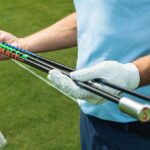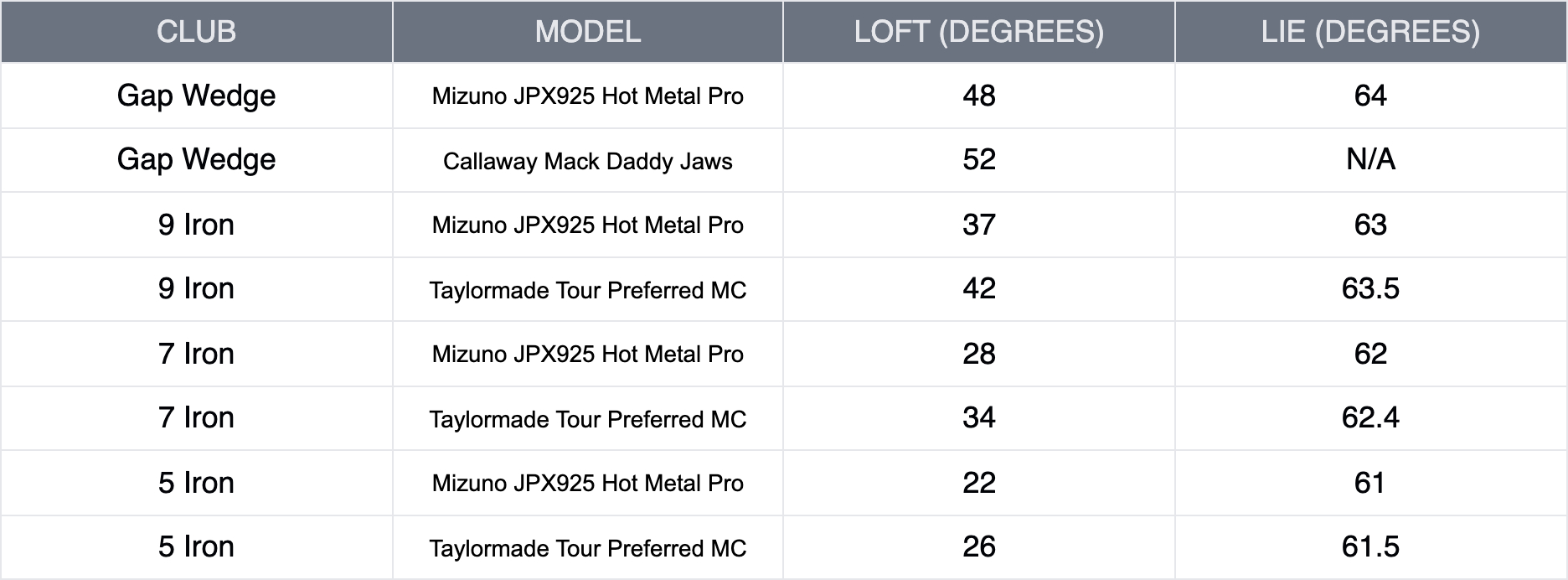For golfers seeking irons with a blend of advanced technology and high performance, the Mizuno JPX925 Hot Metal Pro Irons are well worth considering. Equipped with new engineering aimed at developing your game, these irons will work in the hands of both seasoned high single-figure golfers and those looking to make substantial improvements in their game.
Mizuno JPX925 Hot Metal Pro: Tech Breakdown
The JPX925 Hot Metal Pro Irons feature several innovative technologies. Mizuno’s new Contour Ellipse offers a re-engineered multi-thickness face that’s just 1.2mm thick (12 sheets of paper) — a 30% improvement over the JPX923. The face shape is angled high toe to low heel, catering to common mishit patterns and helping to maintain ball speed, even on off-centre hits.

A seamless cup face provides thinner areas around the perimeter, increasing CORAREA (Coefficient of Restitution) for maximum ball speed across the clubface, while the new multi-material construction with nickel tungsten weighting in the 4-7 irons, creates a higher launch and lower sweet spot to benefit turf shots and improve green-holding capabilities.
The Hot Metal Pro’s variable sole thickness also enables efficient face flex, enhancing CORAREA, with the balance stability frame helping to improve control and forgiveness, providing a solid, tour-preferred feel and sound.
The addition of Harmonic Impact Technology helps to enhance the feel by focusing on sound during the strike. Finely-tuned head geometry offers crisp feedback, with the Acoustic Sound Ribs improving feel and the Sound Bar eliminating tinny or clicky frequencies.

Mizuno JPX925 Hot Metal Pro: Testing
Loft and Lie Angles — JPX925 Hot Metal Pro against control
To note, the Taylormade Tour Preferred MC is the 2011 model.
Performance Stats
During testing, the JPX925 Hot Metal Pro Irons showed impressive results. They averaged an 11.8-yard increase in carry distance (+8%) and a 5.35 mph increase in ball speed (+4.65%). The launch angle was lower by 3.2 degrees (-13.65%), the apex was 4.4 feet lower (-0.04%), and the landing angle decreased by 2.25 degrees (-4.79%).
These differences can be partly attributed to the varying loft and lie angles of the control irons: Taylormade Tour Preferred MC and Callaway Mack Daddy Jaws wedge. Despite this, the JPX925’s performance metrics are notably impressive.

The gap wedge sits at 48 degrees — which could pass as a pitching wedge — in comparison to my 52 degree, which explains the small difference in launch and landing angle.
However, there was an average increase in ball speed of 6.2mph. Part of this can be accounted for by the 4-degree difference in loft, but the angle of attack remained consistent throughout testing, pointing to the newly engineered multi-thickness face — which my 52-degree doesn’t have.
The Contour Ellipse multi-thickness face offers a 30% improvement on the JPX923s, with the high toe to low heel face angle helping golfers find improved ball speed and consistency through a forgiving face. This is evident in the stats, seeing an average 5.85% gain in ball speed.
There was also an average increase of 15 yards, from 125 to 140 yards, which is a fairly impressive number for a gap. Understandably, the loft places it very close to a PW. But considering it sits on the line between a PW (44-48°) and a gap (48-52°), the numbers are more than positive.
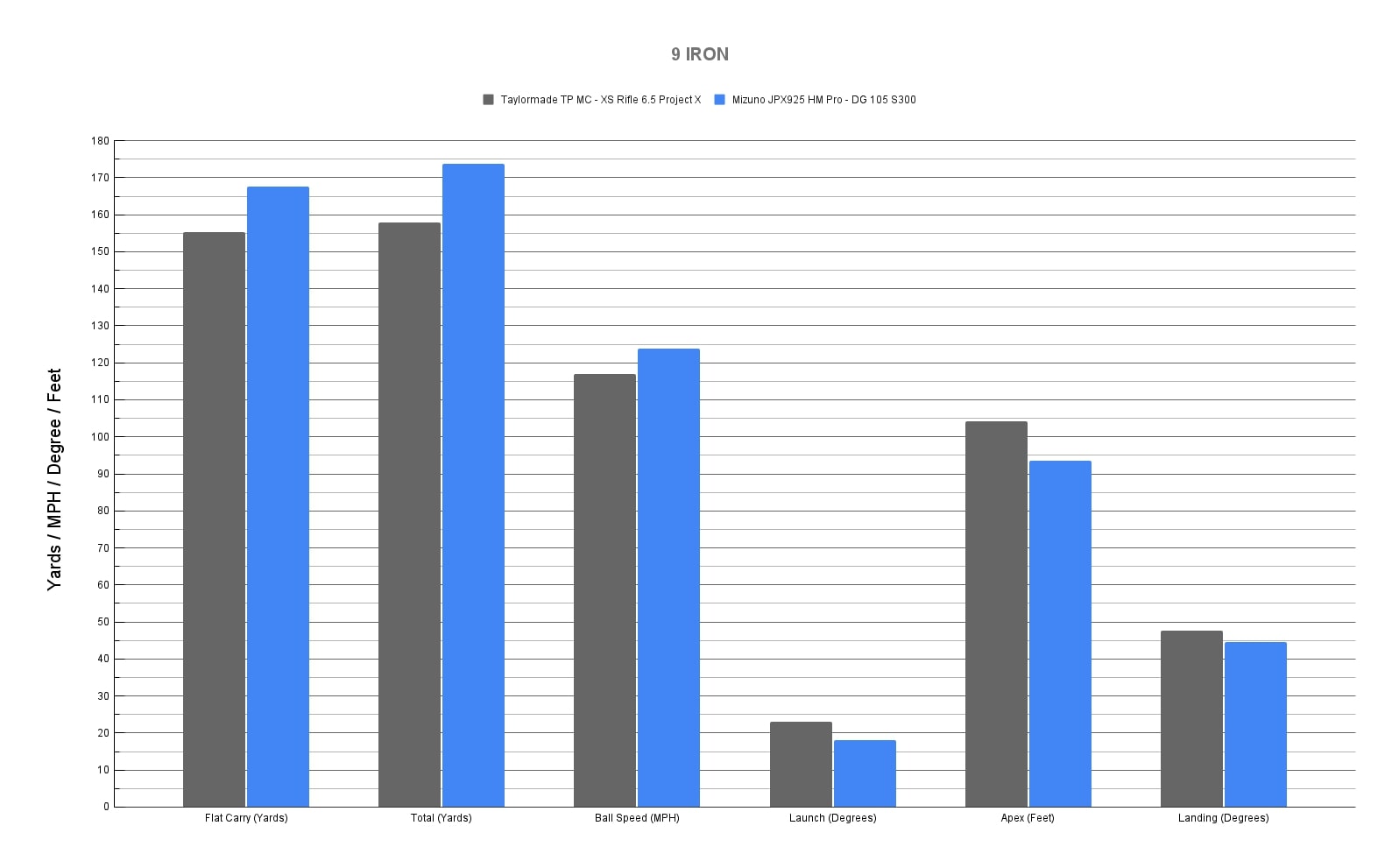
As shown in the loft and lie table above, the Mizuno JPX925 Hot Metal Pro Irons carry a lower loft than the control irons, which is why the distance comparable to the same iron is further and the launch, apex and landing is ever so slightly lower.
The average flat carry distance increase for the 9 iron was 12.4 yards, up from 155.2 to 167.4 yards (+7.98%), while the ball speed was up again on average by 6.8mph (+5.81%).
A lower apex is to be expected with a 5° difference in club. However, the average apex for the JPX925 Hot Metal was still at 93.6 feet, which according to Trackman, is just 3.6 feet short of the tour average for a 9 iron.

Before we even get to the 5-iron stats, it’s clear to see a pattern forming. As with the 9 iron, the flat carry, total distance and ball speed are up, while the launch, apex and landing degrees are down.
I saw an average flat carry increase of 14.4 yards, up from 178.4 to 192.8 yards (+8.07%), with a total average distance gain of 17 yards, from 185 to 202 yards.
This correlates with the impressive average increase in ball speed of 8.4mph (+6.51%). For every mile-per-hour increase in ball speed, the ball can travel an additional two yards, meaning that by gaining 8.4mph, I would find an extra 16.8 yards. When you look at the average carry and total distance gained, the math isn’t far off.
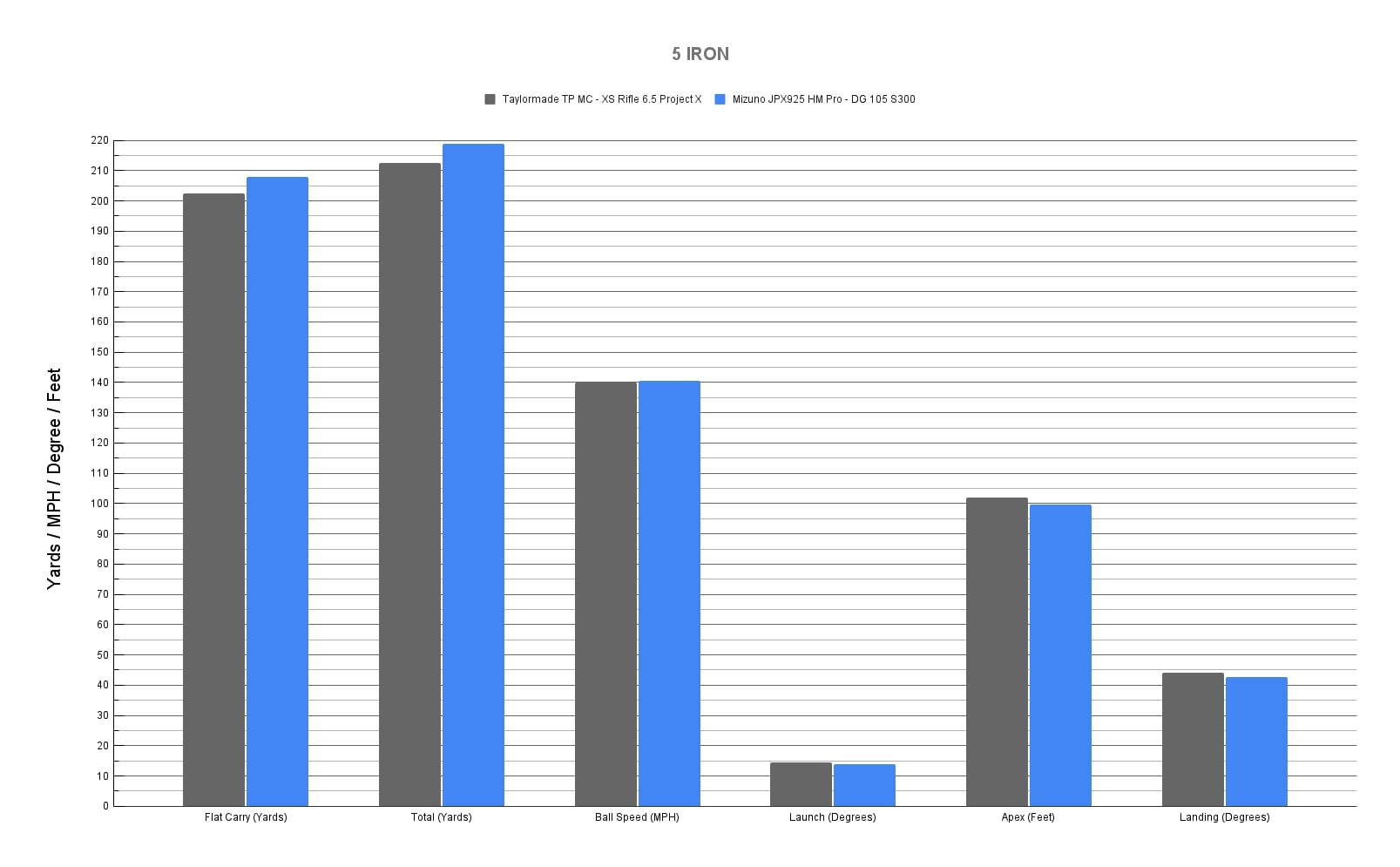
By now, it’s clear to see what the Mizuno JPX925s have to offer. By setting the irons in a lower loft, incorporating a multi-thickness construction and a seamless cup face to increase the coefficient area of restitution, the ball speed is both improved and maintained. The stats show that the distance is up consistently with only a marginal difference in launch and landing angle.
As mentioned previously, my irons (the control), have a higher loft in comparison to their counterparts. The five-iron loft in the Taylormade TP MC ’11 is 26°, whereas the JPX925 Hot Metal Pro is 22°. So to only have an average launch angle difference of -0.6% (down from 14.6° to 14°) with the 5 iron is a testament to the nickel tungsten weighting found in the 4-7 irons.
This engineering is aimed at helping the high single-figure and mid-to-high handicappers improve their launch and landing angle for better control and green-holding capabilities, while the increased ball speed helps to deliver the added distance many a club golfer is looking for.
Mizuno JPX925 Hot Metal Pro: Look and Feel
The JPX925 Hot Metal Pros offer a visually appealing and confidence-inspiring design. The non-glare white satin brush finish gives the clubs a modern image while maintaining Mizuno’s traditional look. The wider sole design increases the overall face flex area to provide added forgiveness and as a result, makes the clubs look powerful yet manageable when addressing the ball.
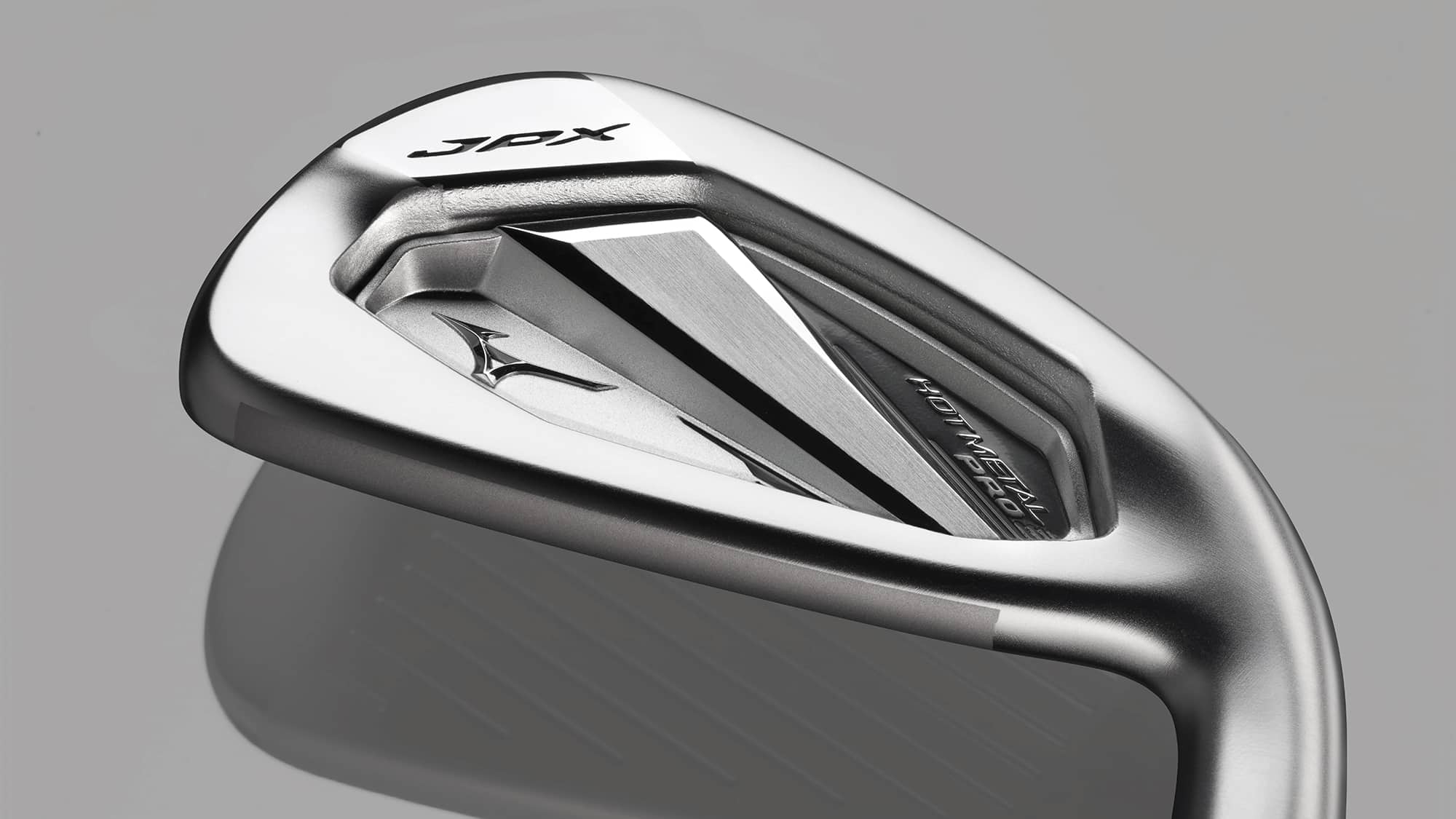
In terms of feel, the weighting of the club is well-balanced, promoting a smooth, rhythmic swing. Pure strikes produce a satisfying sound, with the ball launching crisply off the face.
This design is particularly beneficial for players who struggle with distance from the rough, as the tungsten weighting in the 4-7 irons helps to create a higher launch angle and ensure ample distance — ideal for approaches into the green.
It’s also important to note that not all shots were struck cleanly during the testing — which won’t come as a surprise to anybody. This being said, the JPX925 Hot Metal Pros still performed consistently, especially in dispersion rate and shot shape. The forgiveness of the irons is a huge asset, allowing you to trust each club and shot you stand over.
Mizuno JPX925 Hot Metal Pro: Verdict
The Mizuno JPX925 Hot Metal Pro Irons are a smart choice for golfers seeking to improve their iron game. They offer a commendable mix of distance, forgiveness, and a higher ball flight, making them suitable for both game improvement and high single-figure handicappers.
The engineering is cleverly designed to provide a player with the tools they need to grow their game and build confidence on the course. With appealing aesthetics, excellent feel, and consistent performance, these irons would be a reliable addition to a good majority of golf bags.
